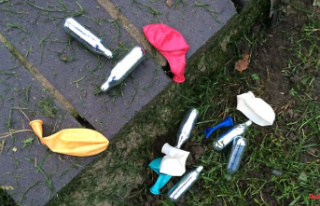Russia terrorizes Ukraine with kamikaze drones, rockets and cruise missiles. Kiev's air defense system is incomplete. Systems from the West should help, including the state-of-the-art German air defense system Iris-T. But even this does not guarantee comprehensive protection.
There is a new escalation in the Ukraine war: Last Tuesday, a rocket landed in south-eastern Poland, just seven kilometers from the Ukrainian border. Two people die. In the evening there is speculation in the media that it was a Russian missile. The Ukrainian President Volodymyr Zelenskyj also suspects this. After all, according to the Polish government, it is an S-300, a Soviet-designed anti-aircraft missile. This type is used by several countries, including Russia, but also Ukraine.
A day later, NATO Secretary General Jens Stoltenberg said the incident was likely caused by a Ukrainian anti-aircraft missile fired to repel Russian missile attacks. But that's not Ukraine's fault. According to Stoltenberg, Russia bears the responsibility because Moscow is constantly continuing the illegal war against Ukraine.
Ukraine's air defense has a lot to do at the moment. On the same day that the missile landed in Poland, Russia also fired heavily on the Ukrainian power grid. Ukraine counted more than 90 rockets and cruise missiles within 24 hours. At two Ukrainian nuclear power plants, reactor units were automatically shut down for safety reasons, according to Zelenskyy. Millions of people were without electricity. In Kyiv alone, the electricity went out in around ten million households, the Ukrainian government announced. Several residential buildings were hit in the capital.
Colonel Markus Reisner on ntv assesses the situation as "chaotic". The Ukrainian air force has to hit targets coming from different directions. "Of course it can happen that missiles that don't hit their targets are misguided and then hit somewhere else," says Reisner.
The Russian attacks have weakened Ukraine's air defenses. In the first days of the war, the Russian army specifically attacked them, reports Reisner. In the summer, the Ukrainian army used anti-aircraft defense to protect its staging areas, i.e. the areas where troops and weapons are stored. In preparation for the offensives against Russia. But there was a lack of supplies for the Ukrainian air defense. The arsenals of anti-aircraft missiles have been emptied, reports Reisner.
Getting ammunition supplies is difficult. Because the Ukraine uses systems of Soviet design. "So you can't supply Ukraine with S-300 missiles because they don't exist in Europe," says the military expert. That's why it's important to deliver European or American systems quickly: "Then there's the quantities of ammunition that are suitable for continuing this defensive fight."
There are different figures on how many anti-aircraft systems Ukraine has. The British research institute International Institute for Strategic Studies (IISS) counts 322 longer-range air defense systems in Ukraine in its report "Military Balance 2021". 250 of these are therefore the Soviet S-300 systems. 72 of them are Buk systems, which were also developed in the Soviet Union and are still used by the Russian army today.
According to military expert Gustav Gressel from the European Council on Foreign Relations, Ukraine has much fewer anti-aircraft systems, only 10 Buk and 31 S-300 systems.
It is not clear how many of these are still left after around eight months of war. Ukraine has already lost many anti-aircraft systems to Russian attacks, says Markus Reisner.
Since October, the Ukrainian military has also been able to use the most modern anti-aircraft system of all: the German Iris-T SLM. Germany delivered one of these to Ukraine. In June, Chancellor Olaf Scholz promised Ukraine the anti-aircraft system - three months later Germany delivered it.
Even the German armed forces are not yet using Iris-T. You shouldn't get it until 2025. The weapons system from the German armaments company Diehl Defense costs 140 million euros.
Iris-T consists of a radar facility, a command post and three rocket launchers mounted on trucks. This makes it mobile. The system can fire at targets up to 40 kilometers away - or at an altitude of up to 20 kilometers. This can be used to shoot down helicopters, airplanes, cruise missiles or ballistic missiles. The 360-degree radar determines from which direction the attack is coming. The fine adjustment is then taken over by the rocket at the end, its seeker head can react to infrared. GPS control is also built in.
Iris-T spans a kind of protective screen and can protect a medium-sized city like Nuremberg or Hanover. This allows Ukraine to protect its government centers, critical infrastructure and logistics centers, says retired Colonel Ralph Thiele at ntv. Of course, that's just a start. In this big country they need a lot more of it.
Germany wants to send three more of these air defense systems to Ukraine. However, only next year. For the manufacturer Diehl Defence, it is difficult to produce these "highly complex, state-of-the-art systems", says Federal Defense Minister Christine Lambrecht.
"We expect that combat operations will now slow down significantly in winter," argues Ralph Thiele. It only really starts again in the spring. And Germany doesn't have any more such systems anyway.
So far, Iris-T seems to have done its job well. The Ukrainians praise it as very accurate. It has apparently already saved many lives, especially around Kyiv. The "Economist" writes that the air defense system has so far shot down every projectile "that got in its way".
There is no 100 percent protection against enemy flying objects, for example because many objects attacking at the same time can also overwhelm Iris-T. But that could also happen with other air defense systems, says Markus Reisner at ntv.
"The problem with all these defense systems is the factor of oversaturation. If the enemy attacks with many drones at the same time like a swarm, then the problem is that the defense system only has a certain number of missiles with it and with fifteen drones, twelve will be shot down, but three will hit their target. And if the three hit relatively precisely, then the target is still destroyed," explains Reisner.
The drones that Russia is currently mainly using are a massive problem for Ukraine: the Iranian kamikaze drones Shahed-136. They are only 2.50 meters wide and 3.50 meters long, but they are destructive. Russia has ordered around 2,400 drones from Iran, the Ukrainian secret service estimates. Russia wants to produce them itself in the future, reports the Washington Post. This would allow Moscow to expand the attacks.
Russia uses these unmanned, propeller-driven drones to attack Ukrainian cities. They have already destroyed around 40 percent of Ukraine's energy infrastructure.
"Not every drone gets there. But in the end they have proven to be a comparatively effective weapon. The citizens of Kyiv must have felt that," says security expert Markus Kaim from the Science and Politics Foundation at ntv. It has become clear "that the Ukrainian air defense system has significant weaknesses. It was able to bring down many of these kamikaze drones. But in the end, comprehensive protection was not possible."
The kamikaze drones are slower than rockets or cruise missiles, but fly lower. And can use a satellite communication system to head directly for stationary targets.
The drones ensure that Ukraine fires its valuable ammunition at them. They are cheap - especially compared to Iris-T rockets - and easy to manufacture.
Destroying the Shahed-136 is difficult. Because they are relatively small, the anti-aircraft systems could not capture them so easily, explains Markus Reisner ntv.de. You need systems with the right sensors for that. These would recognize the drones. Rockets or machine guns could then intercept them. You need air defense systems with the appropriate range, according to Reisner at ntv.
The USA, Norway and Spain are therefore helping out. In early November, the three states delivered air defense systems to Ukraine. They are ground-based systems of the Nasams and Aspide type. They come from US and Italian production. The US also plans to deliver four short-range Avenger mobile air defense systems. In addition, there are the matching Stinger missiles and other missiles for the older Hawk air defense systems that Spain has promised Ukraine.
In April, Slovakia also delivered an S-300 system to Ukraine.
Ukraine would also like to have Israel's Iron Dome anti-aircraft shield. So far, however, Israel has refused to deliver it. In general, arms deliveries to Ukraine are taboo for the Israeli government. She does not want to jeopardize her relations with Russia and has therefore been largely neutral so far.
There is no comprehensive protective shield for the whole of Ukraine, warns military economist Marcus Keupp from ETH Zurich on ZDF. The country is just too big. Each air defense system can only protect a specific target. Part of the air defense was transferred to the Donbass and the front. "These systems are now missing in the Kyiv area or in the other cities or in the energy infrastructures," explains Keupp.
In addition, air defense must be complex, different weapon systems must support each other, writes Gustav Gressel on Twitter. Russia uses many different weapon systems. In addition to combat drones, ballistic missiles, cruise missiles and anti-aircraft missiles. They would each have a very different range, speed and altitude.
So Ukraine needs many different air defense systems to defend against the Russian attack storm. And also the ammunition for it.












